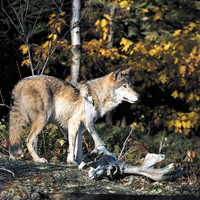Eastern Wolf
Scientific name: Canis sp. cf. lycaon

Photo credit: J.D. Taylor
Status
Threatened
Threatened
means the species lives in the wild in Ontario, is not endangered, but is likely to become endangered if steps are not taken to address factors threatening it.
Date added to the Species at Risk in Ontario List
Eastern Wolf (Canis lupus lycaon) was listed as a special concern species when the Endangered Species Act, 2007 took effect in 2008, and was renamed Algonquin Wolf (Canis sp.) and reclassified as threatened on June 15, 2016.
This updated name does not change:
- the protections given to the species under the Endangered Species Act, 2007
- the applicability of any policies, permits and agreements, guidance documents (including recovery guidance), or best management practices that have been published or issued by the Government of Ontario
Read the most recent assessment report [PDF]
What it looks like
Eastern Wolf is a member of the canine family. Eastern Wolf is larger than a Coyote and smaller than a Grey Wolf. Proper identification requires genetic data as it is difficult to visually distinguish due to its similar appearance (coloration and markings) and overlap in size.
Where it lives
Eastern Wolf is not restricted to any specific habitat type but typically occurs in deciduous and mixed forest landscapes. Itis found to be most prevalent in areas with abundant prey, such as Beaver, White-tailed Deer and Moose along with low levels of human-caused mortality. Eastern Wolf lives in family based packs. Den sites are typically found in conifer dominated forests close to a permanent water source. Suitable soil to construct a den, such as sand, is necessary for excavation.
Where it’s been found in Ontario
Ontario’s Eastern Wolf population is estimated to be between 350 and 1000 mature individuals. A core concentration of Eastern Wolf can be found in Algonquin Provincial Park and surrounding townships. Eastern Wolf is also found in other areas of central Ontario, including in and around Killarney Provincial Park, Kawartha Highlands Signature Site, and Queen Elizabeth II Wildlands. It has also been recorded on Manitoulin Island and in the Sault Ste. Marie area. Eastern Wolf populations found outside of Algonquin Park are small and relatively isolated.
What threatens it
Eastern Wolf faces a variety of threats, including:
- human-caused mortality, although this threat is not increasing in most areas of Ontario
- disease, such as rabies or mange
- competition with other canids
- road-related mortality
Action we are taking
This species and its habitat receive protection under Ontario’s Endangered Species Act, 2007 (ESA).
Since it is difficult to distinguish Eastern Wolf from other species, we have prohibited hunting and trapping of wolves and coyotes in the core Eastern Wolf occurrence areas.
You can download a map [PDF] showing the core Eastern Wolf occurrence areas where hunting and trapping of wolves and coyotes is prohibited.
Under section 1.1 of Ontario Regulation 242/08 (General), when you are outside of these areas, you are exempt from the species (section 9) prohibitions of the ESA while hunting and trapping Eastern Wolf, as long as you’re hunting and trapping in accordance with the Fish and Wildlife Conservation Act, 1997 and its regulations.
The ESA requires us to prepare recovery guidance for threatened species such as Eastern Wolf.
All species listed on the Species at Risk in Ontario List may be eligible for consideration for government funding through the Species at Risk Stewardship Program.
What you can do
Report a sighting
Submit your observations of species at risk to the Natural Heritage Information Centre (NHIC), which is Ontario’s conservation data centre. Join the Centre’s "Rare Species of Ontario" project in iNaturalist, an online plant and animal identification app, to make submitting your observations quick and easy.
Volunteer
Volunteer with your local nature club or provincial park to participate in surveys or stewardship work focused on species at risk.
Be a good steward
Private landowners have a very important role to play in species recovery. If you find species at risk on your land, you may be eligible for stewardship programs that support the protection and recovery of species at risk and their habitats, such as the Species at Risk Stewardship Program.
Report illegal activity
Report any illegal activity related to plants and wildlife to
Quick facts
- Ontario is home to the majority of the global range for the Eastern Wolf. The species is also found in Quebec.
- Eastern Wolf mortality as a result of hunting and trapping has decreased significantly, due to a ban on hunting and trapping the species in the townships adjacent to Algonquin Provincial Park.